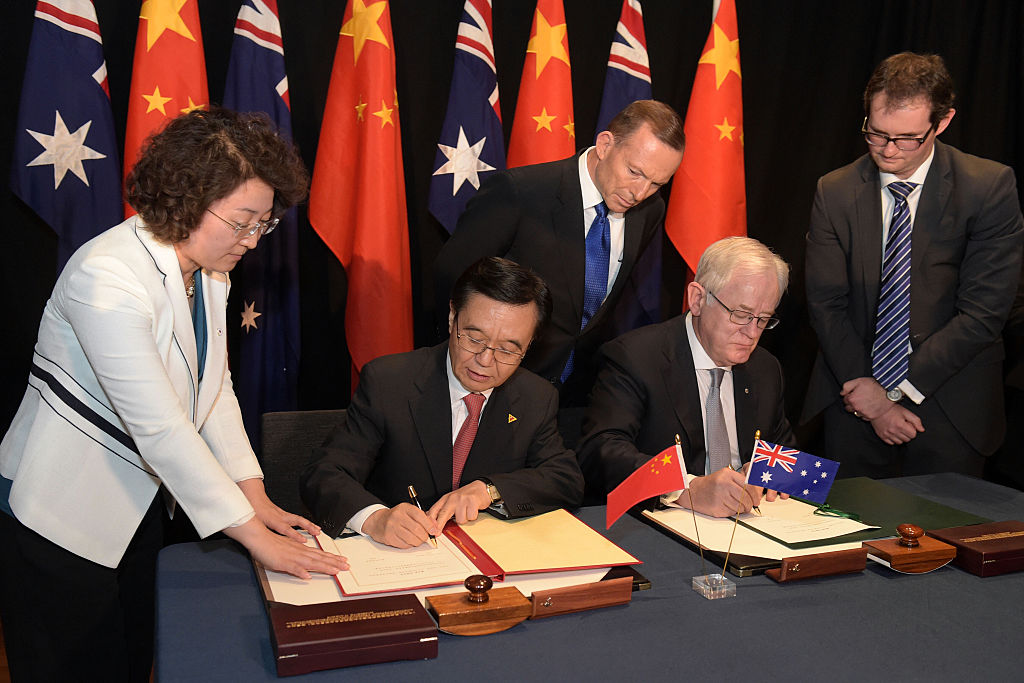 In late 2015, Australia and China signed the China-Australia Free Trade Agreement (ChAFTA), a landmark agreement that had China making liberalization commitments to Australia beyond any previous deal. Negotiations started in 2005 and continued through successive Australian Labor and Liberal governments, then were completed in the same year as Australian deals with Japan and South Korea.
In late 2015, Australia and China signed the China-Australia Free Trade Agreement (ChAFTA), a landmark agreement that had China making liberalization commitments to Australia beyond any previous deal. Negotiations started in 2005 and continued through successive Australian Labor and Liberal governments, then were completed in the same year as Australian deals with Japan and South Korea.
For Australia, the ChAFTA is the most consequential of its three Northeast Asian FTAs (the other two being with Japan and South Korea). China is Australia’s largest trading partner, the second-largest economy in the world, as well as one of the most dynamic economies. Moreover, there are growing market opportunities as China’s middle class grows rapidly.
For China, the agreement is the most ambitious and advanced that it has completed with any country. Beyond significant market access to the growing Chinese agriculture and goods markets, the agreement opened the way to varying degrees for Australian companies in key service sectors such as finance, legal, education, telecommunications, tourism, health, and aged care. The commitments that China made in ChAFTA are consistent with the objectives of its own reform agenda to transform the growth model from being export- and investment-led to a consumption- and services-led model.
ChAFTA serves as a small external lever and beachhead in financial and other service sector reform in China, and as an important testing ground for bilateral agreements with larger advanced economies, including Canada.
Bumps Along the Road to Agreement
The negotiation and ratification of ChAFTA were not without difficulties. One of the main sticking points was a temporary worker memorandum of understanding in the agreement, which caused a backlash from parts of the Australian population that feared an influx of cheap Chinese labour. The provision basically allowed for treatment of temporary Chinese workers equal to that of other workers on temporary worker visas, but the provision was not explicit on that issue and not made clear to the public, which feared a flood of Chinese workers. Starting in mid-2015, the Australian Council of Trade Unions, the country’s main organized labour body, made its opposition to this provision known.

Members of Australian labour unions gather in protest of a Free Trade Agreement (FTA) with China in Sydney on July 31, 2015. Around 1,000 unionists attended the rally to condemn the federal government for signing the Free Trade Agreement (FTA) with China, saying it threatens Australian jobs, wages and conditions. | Photo by Peter Parks/AFP/Getty Images
In response to these concerns, the opposition Australian Labor Party, the major centre-left party, required additional safeguards for Australian workers to allay two types of concerns: one that Chinese temporary workers would be “flying in” to take jobs without employers first demonstrating a local labour shortage, and another that skilled temporary workers like electricians or nurses would be working without meeting standard Australian licensing requirements. By October 2015, the government and opposition reached an agreement that salaries of Chinese temporary workers would match corresponding Australian rates.
On balance, the broader Australian public was in favour of the agreement. There is recognition among Australians that China is the most important foreign economy to Australia. A 2015 poll indicated that a majority in all states except South Australia felt that ChAFTA was a “good thing.” The opposition from South Australia may have been tied to the ongoing decline of that state’s manufacturing industry, once a national hub for car and ship building. Semi-skilled manual workers were most likely to oppose the deal.
Another sticking point was Chinese foreign direct investment – especially from state-owned enterprises – in Australia. At issue was the lack of understanding and fear of investment from companies that have close links to or are controlled by the Chinese government, and the thought that they might be investing for strategic instead of commercial reasons. The concerns echo those that were raised during the early days of Japanese investment in Australia in the 1980s over many companies having strong Japanese government links, support, and backing. Investment in regulatory capacity is the ultimate solution to protecting against any security risks from investment – foreign or domestic – but it also requires political leadership to reassure the public. Much of the fear of new sources of investment comes from a lack of understanding mixed with protectionism and xenophobia. As part of the agreement, however, a commitment was made by both sides to negotiate an improved investment chapter at a later date.
Despite bumps in the road, the parties made the 2015 end-of-year deadline for negotiation completion imposed by Australian Prime Minister Tony Abbott. Contrary to concerns that a rushed deal would lead to an inferior agreement, the final deal was ambitious and did not make any major compromises.

Australian Prime Minister Tony Abbott (C) looks on as Chinese Minister of Commerce Dr. Gao Hucheng (2nd L) Australian Minister for Trade Andrew Robb sign the Free Trade Agreement (FTA) between the two countries on June 17, 2015 in Canberra, Australia. | Photo by Lukas Coch - Pool/Getty Images
Benefits for Australia
Prior to ChAFTA’s ratification, some Australian exporters were at a disadvantage. For example, Australian agricultural products were subject to discrimination, while their competitors in New Zealand and Southeast Asia benefitted from preferential arrangements. For China’s part, its trade and investment in Australia faced barriers that had been lowered for the U.S. and Southeast Asia, and more recently for Japan and South Korea.
ChAFTA removes such barriers to trade for goods and services and liberalizes investment, with more progress expected when the investment chapter is revisited. Up to 85 percent of Australian exports now enter China tariff-free, and that proportion will rise to 95 percent within a decade. The major barriers were in agriculture, where there were tariffs of close to 20 percent on beef, pork, dairy, and wine. These tariffs will now be eliminated. As a result, China’s tariffs on Australian beef will be phased out over a 10-year period, compared with 15 years for South Korea. And in the case of Japan, tariffs on beef will decline to 18.5 percent in 18 years. Rice and sugar were excluded from the agreement, a practice that has become commonplace in similar types of deals.
Beyond levelling the playing field for Australian farmers and agricultural exporters in China, the deal focuses on services and behind-the-border measures – regulatory and other barriers in China’s market beyond tariffs and border measures that inhibit trade, investment, and commerce.
But the agreement’s real potential for Australia depends on whether it can help transform Australia’s economy.
The opportunities that ChAFTA opens up coincide with the structural changes that the Australian economy needs to undertake now that the commodities boom is over. The spectacular, unprecedented commodities boom that Australia experienced over the decade to 2013 brought windfall profits to the natural resource sectors – benefits that accrued to the broader population through substantial appreciation of the currency and increases in real wages. The exchange rate appreciation forced significant changes in the structure of the economy. For example, the already uncompetitive automobile assembly industry and other manufacturers were decimated with the exchange rate appreciation, and these manufacturers retreated from production.
At the height of the commodities boom, mining investment peaked at just under nine percent of GDP. Australia must now shift to a broader set of growth drivers or face lower living standards. This means boosting productivity across industries, particularly in the service sector. To do so will require – among other structural changes – lifting protection on less competitive industries, making the labour market more flexible, and facilitating foreign investment in order to help meet the gap between domestic savings and the country’s most productive investment opportunities.
Thanks to earlier economic reform, the commodities boom, and, more importantly, macroeconomic policies, Australia has enjoyed a quarter-century of uninterrupted growth. That is currently the longest stretch for an advanced economy without a recession.
But continuing Australia’s economic expansion and avoiding an uptick in unemployment requires a shift in growth away from resources toward other sectors of the economy. Services, high-value-add manufacturing, and agricultural exports are where the economy needs to move to restore growth in living standards. In addition, there is a focus on the promotion of innovation as another means of growing the economy. Already, tourism and education have become two of the top five largest export categories for Australia, and China is the largest and fastest-growing market for these services. The structural changes that Australia is attempting to undertake require domestic reforms; ChAFTA helps facilitate some of the change.

A customer selects a bottle of Australian wine at a supermarket on June 17, 2015 in Beijing, China shortly after the signing of the China-Australia Free Trade Agreement. | Photo by Lintao Zhang/Getty Images
Benefits for China
There are two important factors that drove the deal for China that help explain the ambitious commitments that were made.
First, the liberalization that was undertaken in ChAFTA was consistent with China’s reform agenda, specifically the focus on transforming the growth model away from a reliance on exports and investment, dominated by heavy industry, toward a more sustainable services- and consumption-led model.
Second, Australia provided a good testing ground for doing deals with larger advanced economies. Australia is a mid-sized economy but one that is open, with well-established high-quality institutions and regulatory systems. Opening up the Chinese economy to Australian competition can be seen as a step in helping to prepare Chinese institutions, regulations, and the market for broader liberalization.
As a result of this type of liberalization, Australian service providers will be able to enter some sectors in China that were previously closed to foreign competition, and will have better market access to other sectors. Chinese reformers are using liberalization of health-care, financial, and other services in ChAFTA to further the domestic reform and liberalization of the services sector more broadly. The Chinese government has said the agreement has the highest level of overall trade and investment liberalization of all its agreements.
Next Phase
On paper, ChAFTA opens up potentially lucrative markets and opportunities for Australian companies. But only time will tell whether businesses are able to make the most of the agreement. One question is what impediments companies might still find when they attempt to operate in the Chinese market. For the agreement to succeed fully and have real business relevance, close interaction between all levels of both governments, the broader policy community, and the business sectors will be needed.
That interaction will be helped by a mechanism built into ChAFTA that requires officials to negotiate removal of barriers and impediments to trade that become apparent later. Circumstances change, new issues arise. Making the agreement a “living” agreement in this way should mean much larger payoffs. The best example of creating living agreements is in the Association of Southeast Asian Nations (ASEAN), which builds a co-operation agenda into its agreements, requiring close co-operation between governments – which makes a real difference to business. The inbuilt review of new barriers to commerce in ChAFTA is a good start but much more needs to be done.
For example, Australian exporters, especially as they move away from a heavy reliance on natural resource exports, will need to develop a more sophisticated understanding of the Chinese market. As middle-class growth in China leads to higher disposable incomes, Australian firms will need to compete for increasingly discerning customers by tailor-making products and customizing their service offerings.
Finally, Australia still has to come to terms with Chinese investment, especially from state-owned enterprises. The current institutions for screening and regulating Chinese investment have come under immense community and political pressure, just as they did previously (if not so intensely) for investment from the United States in the 1970s and Japan in the 1980s. Chinese investment will become more important for linking to markets and consumers directly in China, as well as for developing Australian tourism and other industries and for investment in infrastructure.
Australia desperately needs to resolve the domestic debate on Chinese investment and find a way to reassure the public that the Chinese investment that is coming in is being screened and that the regulatory institutions are up to the task. Working through these issues with China through the upgrading of the investment chapter in ChAFTA (a requirement under the agreement) will help maintain confidence at the Chinese end that Australia welcomes its investment.
ChAFTA puts China on par with some of Australia’s other FTA partners for its treatment of foreign investment into Australia. The threshold under which foreign direct investment can enter without a screening and review process has been lifted from A$250M to just over A$1B, unless the investment is in agriculture, real estate, or a few other sectors, or is from a state-owned enterprise.
Beyond the liberalization measures, the investment chapter includes a commitment to review the bilateral investment relationship within three years. The chapter lists a number of issues that these future investment negotiations must address, including the scheduling of China’s future investment commitments on a “negative list” basis, whereby sectors are considered open for investment unless they appear on an exclusive list.
Lessons for Canada
The demise of the mega regional Trans-Pacific Partnership agreement, as well as the uncertainty in North American and global trade that a populist and protectionist U.S. president has brought, has elevated the importance of a deal with China for Canada.
The other mega regional agreement in the Asia Pacific, the East Asian Regional Comprehensive Partnership (RCEP), is being negotiated by the 10 Southeast Asian nations of ASEAN, Australia, China, India, Japan, Korea, and New Zealand. That is now the only mega regional agreement in play in the global system and will likely form the basis for a Free Trade Area of the Asia-Pacific.
Although Canada is not now a member of the RCEP, it should position itself to join once the deal is done and the open accession principle is operational. A deal with China can help Canada beyond the bilateral relationship, which will be significant in itself. A Canada-China agreement should be positioned to assist in eventual RCEP accession for Canada. The benchmark for the RCEP was lifted with ChAFTA, as China’s commitments in any future deal will be measured against those in its agreement with Australia.
As Canada proceeds to trade talks with China, it should look to ChAFTA for lessons. The first is to create a living agreement that builds in review and ongoing interaction. FTAs should not be seen as one-shot deals. That includes building in ratchet-up mechanisms that expand market access when either party signs more liberalizing deals with other partners. The commitment to improve on the investment chapter of ChAFTA is an important innovation that demonstrates pragmatism in this regard.
The second is to ensure that the agreement is consistent with the Canadian economic reform agenda. Too often agreements only reflect narrow interests of some exporters, but they offer opportunity for broader liberalization and reform. China has demonstrated its ability to use external agreements strategically to leverage and entrench domestic reforms.
With Europe preoccupied with internal problems and disentangling the United Kingdom from its Union, and the United States becoming a threat to the global economic order it created and sustained, Canada can sensibly focus on deepening co-operation in Asia. Asia needs to keep regional markets open to sustain economic development, and Canada can become an important part of the coalition of economies that are actively trying to lower rather than raise trade barriers.
The views expressed here are those of the author, and do not necessarily represent the views of the Asia Pacific Foundation of Canada.



